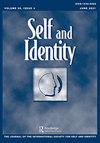高中青少年基于社会认同的攻击性受害行为与心理后果
IF 2.1
4区 心理学
Q3 PSYCHOLOGY, SOCIAL
引用次数: 9
摘要
研究表明,许多青少年报告说,由于他们的社会身份(如种族、性别、性取向),他们在学校受到了伤害。我们比较了基于社会身份的伤害(SIBV)与一般伤害的后果,其中青少年因其他原因(例如,竞争,感知到的侮辱)而受到同伴的伤害。一项针对471名高中生的在线调查得出了777份受害报告。71.2%的学生报告最近至少有一次受害者,53.8%的学生报告SIBV。基于种族的侵害最为普遍,SIBV在网上比在线下更为常见。报告SIBV的青少年的心理反应(即消极影响、自尊和感知成本)和行为反应(即回避、反社会、亲社会和自残行为)显著增加。正如预期的那样,心理反应显著介导了SIBV对行为反应的影响。本文章由计算机程序翻译,如有差异,请以英文原文为准。
Behavioral and psychological consequences of social identity-based aggressive victimization in high school youth
ABSTRACT Research suggests many youth report being victimized in school due to ptheir social identities (e.g., race, gender, sexual orientation). We compared the consequences of social identity-based victimization (SIBV) to general victimization wherein adolescents are victimized by peers for other reasons (e.g., competition, a perceived insult). An online survey administered to 471 high school students yielded 777 victimization reports. 71.2% of the students reported at least one recent vicitimization, with 53.8% reporting SIBV. Race-based victimization was the most prevalent, and SIBV was more common online than offline. Psychological reactions (i.e., negative affect, self-esteem, and perceived costs) and behavioral responses (i.e., avoidant, antisocial, prosocial, and self-harm behavior), were heightened for youth reporting SIBV. As anticipated, psychological reactions significantly mediated the effect of SIBV on behavioral responses.
求助全文
通过发布文献求助,成功后即可免费获取论文全文。
去求助
来源期刊

Self and Identity
PSYCHOLOGY, SOCIAL-
CiteScore
5.10
自引率
5.00%
发文量
26
期刊介绍:
Work on self and identity has a special place in the study of human nature, as self-concerns are arguably at the center of individuals" striving for well-being and for making sense of one"s life. Life goals develop and are influenced by one"s view of what one is like, the way one would ideally like to be (or would like to avoid being), as well as one"s perceptions of what is feasible. Furthermore, conceptions of self and the world affect how one"s progress towards these goals is monitored, evaluated, redirected, re-evaluated, and pursued again. Thus, the “self” as a construct has far-reaching implications for behavior, self-esteem, motivation, experience of emotions and the world more broadly, and hence for interpersonal relationships, society, and culture.
 求助内容:
求助内容: 应助结果提醒方式:
应助结果提醒方式:


